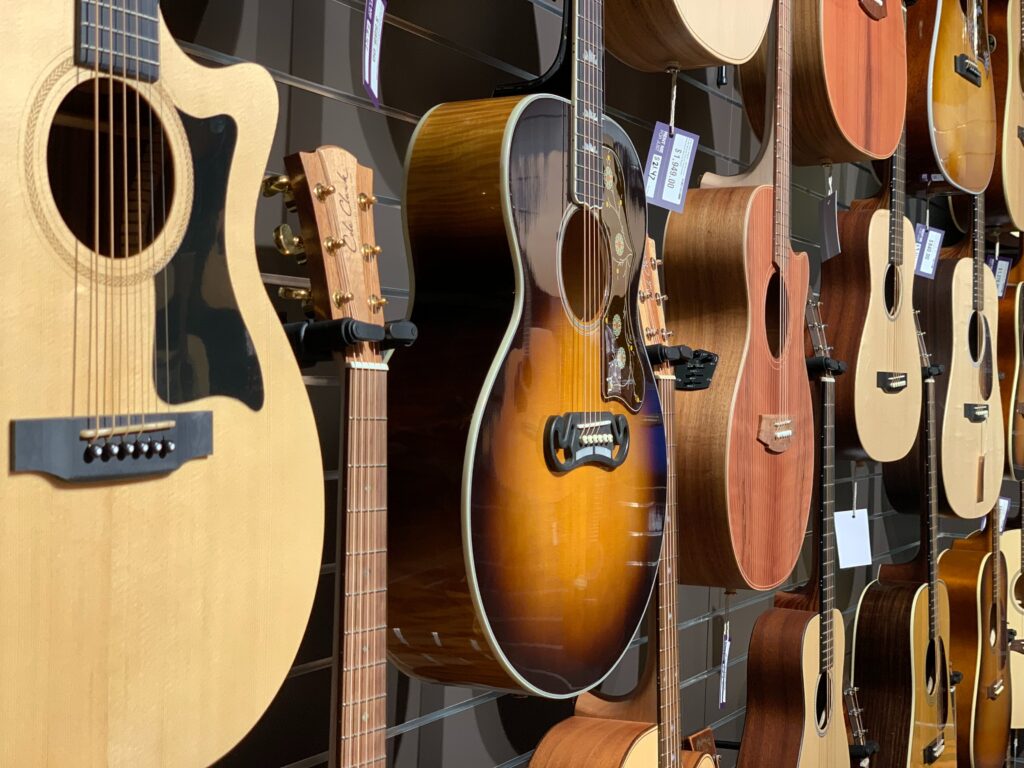A Closer Look at the Acoustic Guitar
No matter what instrument you play, understanding how it was made and how it works is important. This knowledge will help you troubleshoot any issues you have and help you get the best sound possible out of your instrument.We’re going to break down the different components of your acoustic guitar and the types of materials used to make this versatile instrument.
Parts of the Acoustic Guitar
Whether they’re manufactured or built by hand, acoustic guitars need to be made with a lot of care. Each of these components of an acoustic guitar is important in its own way and has unique attributes:
- Top: The top of the guitar has a few components too, with the main part being the soundboard. To get the best sound, the soundboard has to be light but strong and both rigid and flexible. This sounds like it should be impossible — how can one piece have each of those characteristics at once? It is possible, and it’s key.
- Back: After you strum a note or a chord on your guitar, the sound will bounce around the inside of the guitar. The back of the guitar helps project that sound back out and towards the listener. The piece of wood used for the back of the guitar will be thicker than the one used for the top. This helps give you more volume and greater projection.
- Sides: Like all the parts of the acoustic guitar, the sides are made to help get the best sound. The sides should be thicker and more inflexible to make sure they do not absorb the vibrations from the strings. This allows the sound to go where it should: back out of the guitar.
- Inside: The inside of the acoustic guitar has a lot of pieces that keep the guitar together. The neck block helps keep the neck secure to the body, the end block keeps the bottom of the guitar from splitting and a protective lining reinforces the sides of the guitar.
- Neck: The neck of the guitar helps carry the vibrations from the strings down to the body of the guitar. Similarly to the sides, the neck needs to be thick and stiff to make sure it doesn’t absorb those vibrations.
Beyond how these components are constructed, the materials used for the pieces of an acoustic guitar are equally important.
Tone Woods
A less-well-known part of an acoustic guitar is the type of material used to make it. Most guitars, in general, are made using wood. Especially for acoustic guitars, this gives them their signature appearance.The woods used to make guitars are commonly called “tonewoods.” Each type of wood, and which part of the guitar it is used to make, affects the tone of an acoustic guitar. If you’re looking for a guitar with a particular tone or an emphasis on different ranges, make sure you look at the tonewoods that were used.Below are some of the popular types of wood used to make acoustic guitars:
- Spruce: As the most common tonewood for tops, spruce’s clean, resonating qualities are enjoyed by many users. This tonewood will give the same crisp sound no matter how it’s played, giving it a great deal of versatility.
- Cedar: Cedar is known for its dark, quieter tone. It tends to lose some clarity when played hard with a pick, making it a top choice for fingerstyle players looking for a sound with strong overtones.
- Mahogany: Mahogany gives a clean sound from the bass to the treble when it comes to range. But it’s also great at giving a bit more emphasis on your lower tones. This tonewood is usually used for an acoustic guitar’s body.
- Koa: If you want a blend of the two types of tone from maple and mahogany, koa is a great tonewood. This type of wood is typically found on the backs and sides of an acoustic guitar and is sought for aesthetics as often as for tone.
- Rosewood: Brazilian rosewood has become a protected type of wood and is more difficult to find, making guitars made from this tonewood much more expensive and difficult to find. However, it creates a warm, rich sound and gives a beautiful look.
